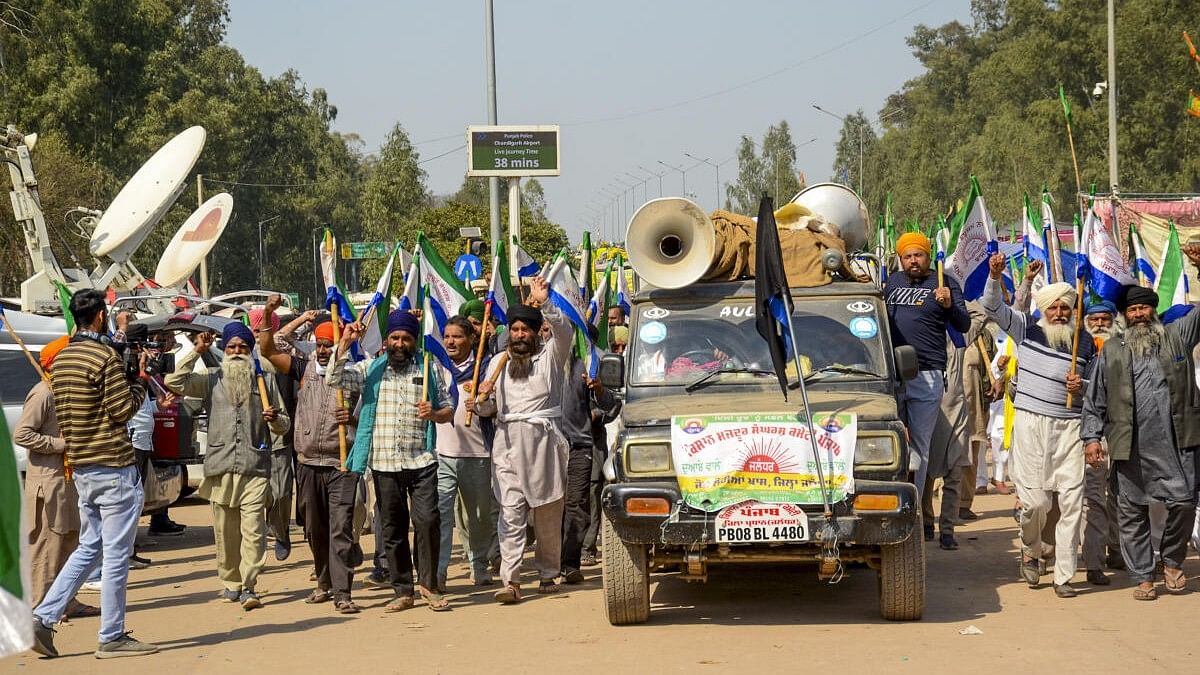
Farmers during their 'Delhi Chalo' march, near the Punjab-Haryana Shambhu border, in Patiala district, Saturday, Feb. 25, 2024.
Credit: PTI Photo
After little over two years after farmers protested at India’s national capital, farmer organisations are back agitating at the borders of New Delhi demanding a legal guarantee for fixing the minimum support price (MSP) for all 23 crops, based on the recommendations that the National Commission for Farmers (NCF, or better known as the Swaminathan commission) made in 2006.
Among other suggestions like fixing the MSP at a minimum of 50 per cent over the total cost of production, the Swaminathan commission also recommended that the ‘net take home income’ of farmers should be comparable to those of civil servants. Therefore, like civil servants, who are assured regular increases in their ‘net take home income’, the farmers are demanding that the MSP, which is increased every year, should be also their legal right.
Although these recommendations were then accepted by the Union government of the day, implying that it had grasped its relevance, they were never implemented in letter and spirit. As can be seen from the table below, the announced MSP remained below the Swaminathan commission’s target for both wheat and rice. The corresponding figures for all the other kharif and rabi crops mirror the trends in rice and wheat.
While the Congress-led United Progressive Alliance (UPA) government ignored the Swaminathan commission recommendations, notwithstanding the repeated submissions by the farmers that farming had ceased to be a profitable business, the Bharatiya Janata Party (BJP)led National Democratic Alliance (NDA) government seemed more sensitive to the farmers’ concerns. In 2016-2017, the then Finance Minister announced that “agriculture and farmers’ welfare with a focus on doubling farmers’ income in five years” would be the first priority of the government’s agenda to ‘Transform India’. ‘Doubling of farmer’s income’ was reiterated in the 2019 election manifesto of the BJP, with the promise that this target would be achieved by 2022.
This promise raised expectations that the government had finally understood that raising farm incomes can provide a strong stimulus for India’s future development prospects, especially when nearly half of the workforce is still engaged in this sector. In fact, during those brief episodes when terms of trade had shifted in favour of agriculture, a virtuous cycle had been set off, resulting in higher demand for manufactured goods. It is, therefore, a no-brainer that improvement of farm incomes is the sine qua non for sustained growth of the Indian economy, which has been this government’s top priority.
However, in its second term, the current government showed little urgency in implementing its election promise of doubling farm incomes. Implementing the Swaminathan commission’s recommendations should have been the first step towards ensuring higher incomes for the farmers; its reluctance to do so was adequately reflected in its recent proposal that government agencies would buy pulses, maize, and cotton crops for five years.
The government finds itself caught in a triple bind on the question of continuing with the MSP, along with a legal guarantee that the farmers’ organisations are demanding. First, it cannot turn its back completely on its political promise of ‘doubling farm incomes’, especially when the ruling BJP will soon be facing the electorate yet again. Second, it must find a meeting ground with the farmers’ organisations, which have proved that they can hold out against the government in the most difficult circumstances, even during the Covid-19 pandemic. Finally, it must respond adequately to the consistent pressures for reducing the farm subsidy bill, not just for the sake of what it considers fiscal prudence, but also for conforming to the subsidies’ discipline imposed by the Agreement on Agriculture of the World Trade Organization (WTO).
The MSP-logjam in which the government finds itself has no short-term solutions. The government cannot withdraw from its decades-old responsibilities of procuring foodgrains for it cannot afford to increase the uncertainties that the farmers are facing in a crisis-ridden sector. Moreover, procurement by its agencies is the best option that the government has for implementing its promise of providing free foodgrains to more than 810 million people under the Pradhan Mantri Garib Kalyan Anna Yojana (PMGKAY) for five years from January 1.
Perhaps more importantly, both the government and the farmers’ organisations must recognise that subsidies reflect the price being paid for the mounting inefficiencies in agriculture. For several decades now, Indian agriculture has slipped into an abyss as farm productivity remains stuck at relatively low levels by international standards. In both major crops, rice and wheat, India’s yield per hectare compares poorly with most of the major producers: it is less than half of the global leaders in rice and about a third in wheat.
This situation should surprise none, given that agriculture has consistently faced dire neglect. The most telling indicator is its steadily declining share in India’s capital formation. In 2011-2012, agriculture’s share was above 8 per cent, but since then it has fallen below 6 per cent — the lowest for any government. This trend must be reversed, for which a comprehensive agricultural policy akin to the Farm Acts of the United States and the Common Agricultural Policy of the European Union must be adopted with the participation of the state governments and farmers’ organisations. The agitating farmers must demand such an agricultural policy, which effectively addresses the frailties of the sector.
Biswajit Dhar is former professor of economics, Jawaharlal Nehru University, and is Distinguished Professor, Council for Social Development, New Delhi.
(Disclaimer: The views expressed above are the author's own. They do not necessarily reflect the views of DH.)